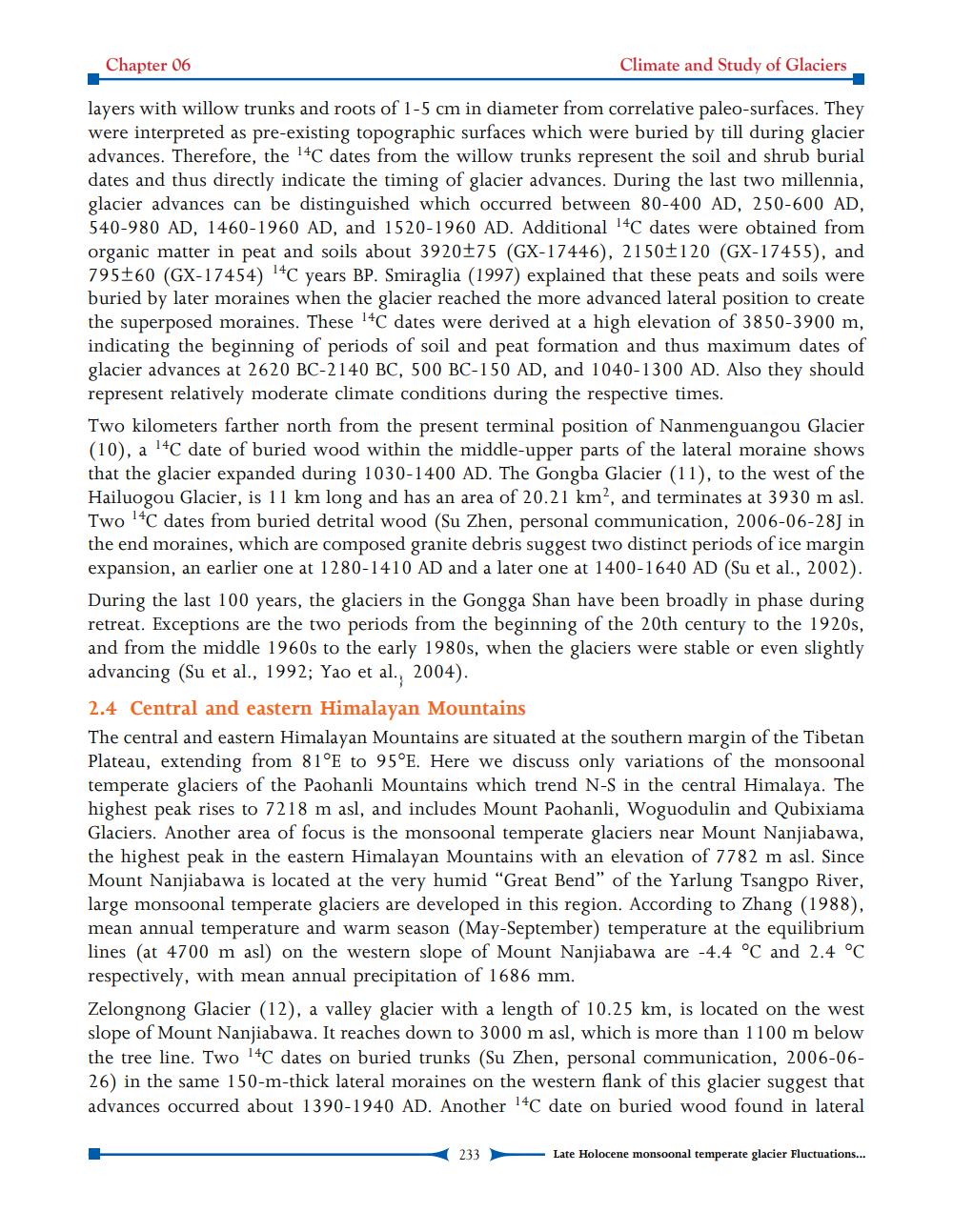________________
Chapter 06
Climate and Study of Glaciers
layers with willow trunks and roots of 1-5 cm in diameter from correlative paleo-surfaces. They were interpreted as pre-existing topographic surfaces which were buried by till during glacier advances. Therefore, the 14C dates from the willow trunks represent the soil and shrub burial dates and thus directly indicate the timing of glacier advances. During the last two millennia, glacier advances can be distinguished which occurred between 80-400 AD, 250-600 AD, 540-980 AD, 1460-1960 AD, and 1520-1960 AD. Additional 14C dates were obtained from organic matter in peat and soils about 3920–75 (GX-17446), 2150–120 (GX-17455), and 795–60 (GX-17454) '°C years BP. Smiraglia (1997) explained that these peats and soils were buried by later moraines when the glacier reached the more advanced lateral position to create the superposed moraines. These 14C dates were derived at a high elevation of 3850-3900 m, indicating the beginning of periods of soil and peat formation and thus maximum dates of glacier advances at 2620 BC-2140 BC, 500 BC-150 AD, and 1040-1300 AD. Also they should represent relatively moderate climate conditions during the respective times. Two kilometers farther north from the present terminal position of Nanmenguangou Glacier (10), a 14C date of buried wood within the middle-upper parts of the lateral moraine shows that the glacier expanded during 1030-1400 AD. The Gongba Glacier (11), to the west of the Hailuogou Glacier, is 11 km long and has an area of 20.21 km2, and terminates at 3930 m asl. Two 14C dates from buried detrital wood (Su Zhen, personal communication, 2006-06-28J in the end moraines, which are composed granite debris suggest two distinct periods of ice margin expansion, an earlier one at 1280-1410 AD and a later one at 1400-1640 AD (Su et al., 2002). During the last 100 years, the glaciers in the Gongga Shan have been broadly in phase during retreat. Exceptions are the two periods from the beginning of the 20th century to the 1920s, and from the middle 1960s to the early 1980s, when the glaciers were stable or even slightly advancing (Su et al., 1992; Yao et al., 2004). 2.4 Central and eastern Himalayan Mountains The central and eastern Himalayan Mountains are situated at the southern margin of the Tibetan Plateau, extending from 81°E to 95°E. Here we discuss only variations of the monsoonal temperate glaciers of the Paohanli Mountains which trend N-S in the central Himalaya. The highest peak rises to 7218 m asl, and includes Mount Paohanli, Woguodulin and Qubixiama Glaciers. Another area of focus is the monsoonal temperate glaciers near Mount Nanjiabawa, the highest peak in the eastern Himalayan Mountains with an elevation of 7782 m asl. Since Mount Nanjiabawa is located at the very humid "Great Bend" of the Yarlung Tsangpo River, large monsoonal temperate glaciers are developed in this region. According to Zhang (1988), mean annual temperature and warm season (May-September) temperature at the equilibrium lines (at 4700 m asl) on the western slope of Mount Nanjiabawa are -4.4 °C and 2.4 °C respectively, with mean annual precipitation of 1686 mm. Zelongnong Glacier (12), a valley glacier with a length of 10.25 km, is located on the west slope of Mount Nanjiabawa. It reaches down to 3000 m asl, which is more than 1100 m below the tree line. Two 14C dates on buried trunks (Su Zhen, personal communication, 2006-0626) in the same 150-m-thick lateral moraines on the western flank of this glacier suggest that advances occurred about 1390-1940 AD. Another 14C date on buried wood found in lateral
233
Late Holocene monsoonal temperate glacier Fluctuations...




